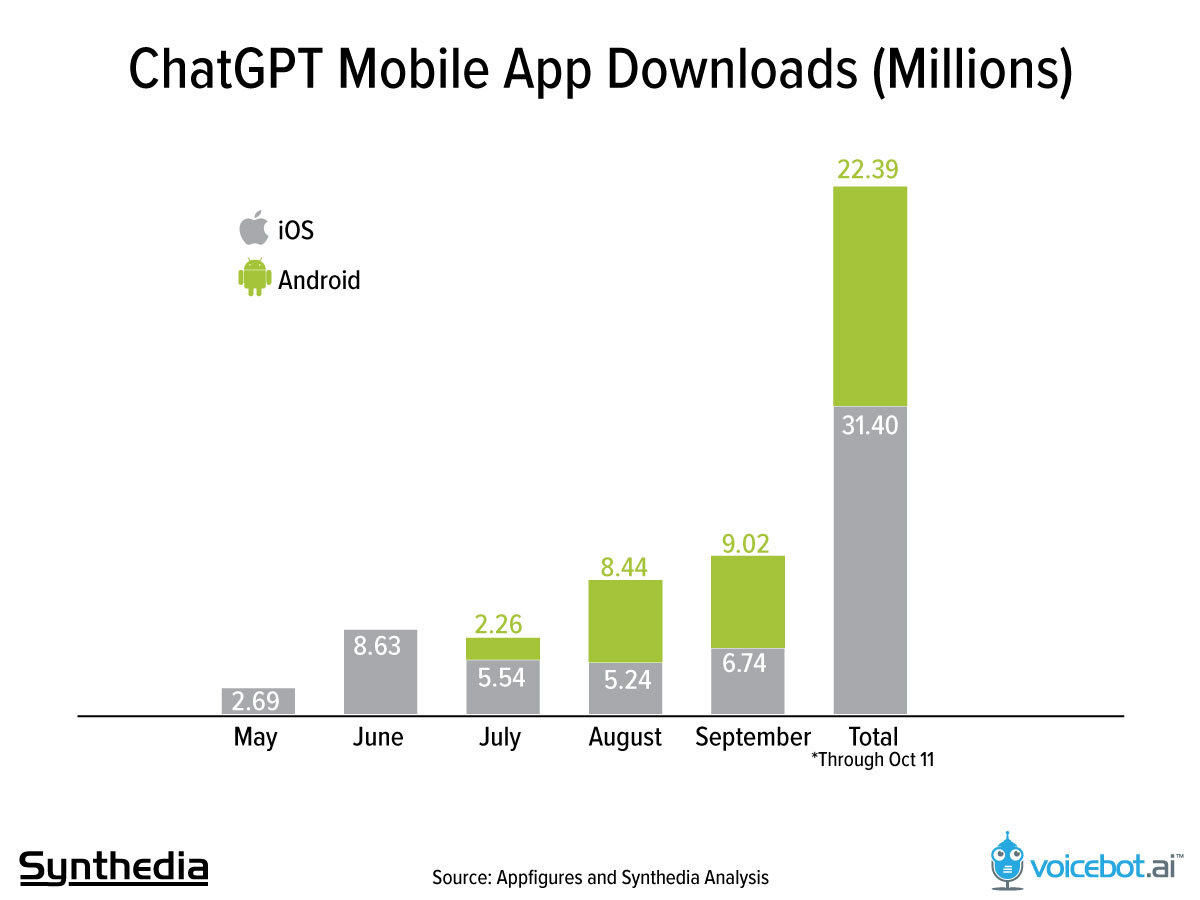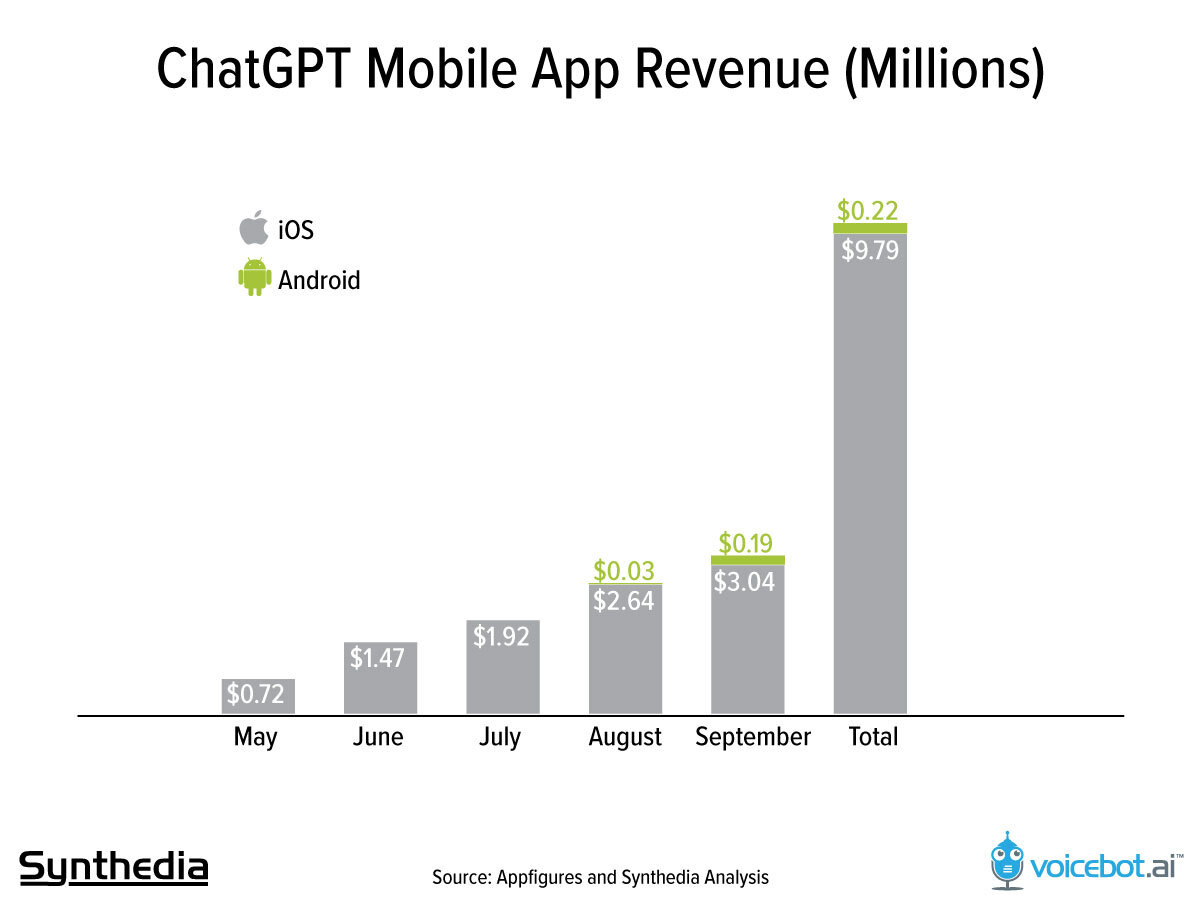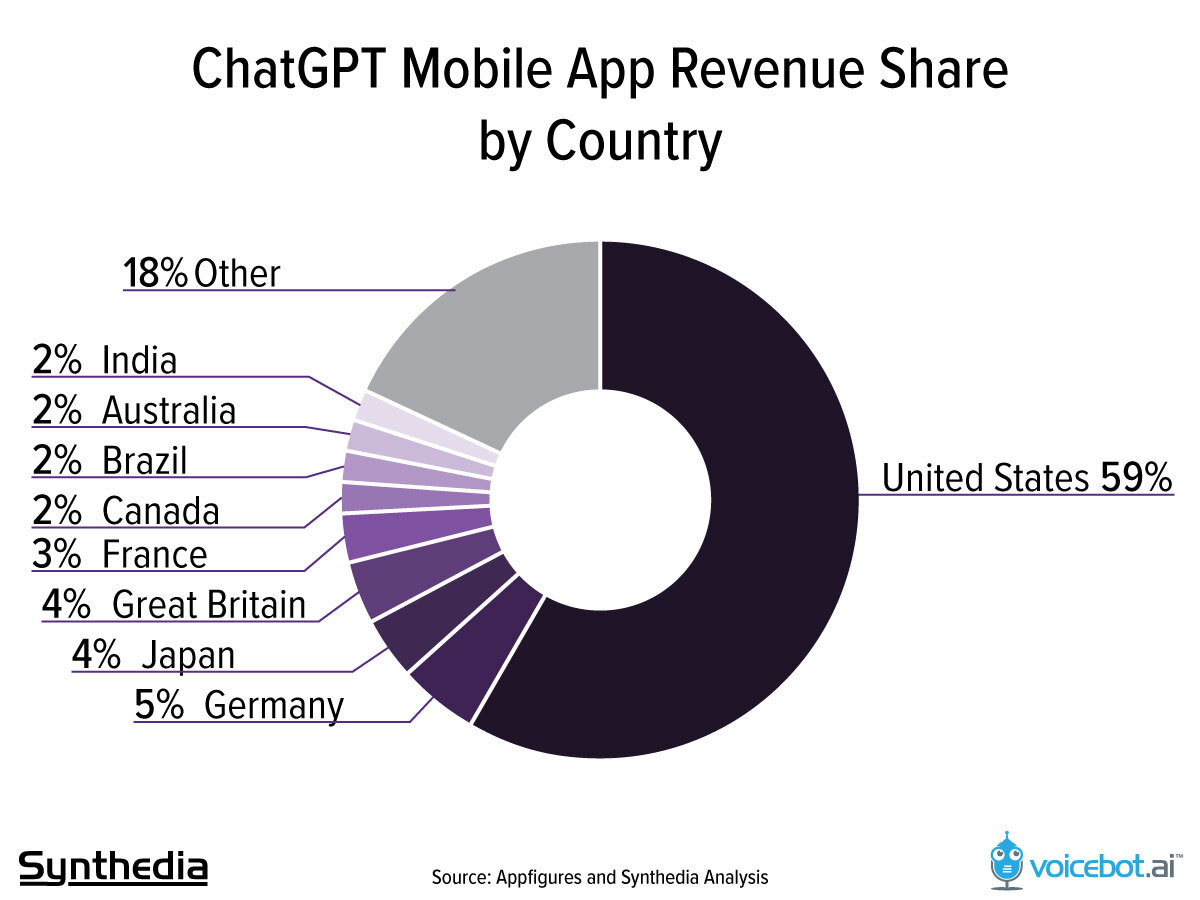ChatGPT Mobile App Tops 50M Downloads, Net Revenue at $3M Per Month - Full Breakdown
Most paying users are not though the mobile app stores
ChatGPT’s mobile app has been downloaded nearly 54 million times, according to tracking data collected by Appfigures. The iOS app launched on May 18th and accumulated over 11.3 million downloads in its first six weeks. OpenAI’s Android app launched on July 27 and tallied 10.7 million downloads in just five weeks.
The first two months when both mobile OS apps were available saw 13.7 and 15.8 million downloads, respectively. The United States is the largest ChatGPT user market, accounting for 20% of all downloads, followed by India at 12% and Brazil at 10%.
Appfigures identified 87 countries with recorded ChatGPT downloads. The U.S. is the lead in terms of adoption, but it is also likely to be where the solution has the highest awareness.
Yipit indicated in July that ChatGPT had 230 million monthly active users (MAU) worldwide, according to Andreessen Horowitz. Reuters reports 180.5 million MAUs as of August, which is based on SimilarWeb estimates that do not account for mobile app users. Appfigures provides download figures and revenue so you can derive paid users, but it does not offer MAU totals or include website users. And, of course, some users access ChatGPT through both mobile and web.
With all of this in mind and other data points, it is safe to say that ChatGPT has over 200 million MAUs for the paid and free versions combined. The vast majority of those users are accessing the service through the web today. It is also true that the vast majority of paying users are accessing ChatGPT through the web, or, at least, set up their paid account on the web and carried that over to mobile when they signed in.
ChatGPT Mobile Revenue
ChatGPT has also earned more than $10 million in mobile app store net revenue from subscriptions. The net revenue is what OpenAI receives after the Apple App Store and Google Play take their 30% transaction fee. That amounted to about $3.2 million in September net revenue from about 230,000 paying subscribers to the ChatGPT Plus service.
Andreessen Horowitz reported in August that OpenAI had two million paid users in the U.S. alone, and Brad Gerstner offhandedly mentioned in a podcast interview that the total user base was four million. This suggests that mobile subscribers account for 5-10% of ChatGPT Plus paid users. It also makes sense given that so many people first used ChatGPT on the web, and the paid Plus service predated the iOS app by nearly four months and the Android app by six. This would also explain why mobile users likely represent as much as 25% of ChatGPT’s user base, but a far smaller ratio of paid users.
ChatGPT Mobile App Revenue by Country
While eight countries account for 60% of ChatGPT’s mobile downloads, a single country accounts for nearly three-fifths of its in-app revenue. Appfigures data show the United States accounts for 59% of ChatGPT net revenue, followed by Germany, Japan, Great Britain, France, Canada, Brazil, Australia, and India ranging from 2% - 5%.
Note that Italy and Russia are the only G8 countries not to rank and represent at least 2% of subscribers. Russia has banned the service. Italy launched a public regulatory inquiry into OpenAI in March, which may have reduced interest in the application.
Most people are well aware that it is expensive to operate ChatGPT, and it looks like some U.S. users are covering most of the cost for free users around the globe. Granted, they are not doing this out of altruism. ChatGPT Plus provides faster results, access to GPT-4, and more features. However, it does show a high level of revenue concentration. Data from Business of Apps suggests that U.S. paid subscribers accounted for just 28% of the total. It will be interesting to see how the user demographics change over the next six months.
ChatGPT Web and Mobile Channels
Mobile apps are a very important channel for ChatGPT users but have not been the key driver of new subscriptions. OpenAI’s ChatGPT web app is the key revenue driver, though many users are also accessing the service via mobile. With that said, the mobile app could become the key driver of new consumer subscription revenue as more features and plugins are added that align more closely with existing mobile use cases.
The Imminent Death of ChatGPT [and generative AI] is Greatly Exaggerated - Look at the Data
“What if Generative AI Turned Out to be a Dud?” “The Rise and Fall of ChatGPT?” These are pretty eye-catching headlines. While Elon Musk is at the vanguard of warning us against the rise of robot overlords, Gary Marcus has carved out a niche as the skeptic of generative AI’s more benign benefits. He brings substantial experience and credentials to the deb…
To Charge or Not to Charge for Generative AI Features - Different Approaches Emerge
How much does it cost users when a generative AI feature lands in your everyday business application? That depends. Microsoft 365 Copilot is an extra $30 per month per user on top of the existing 365 subscription cost. Google Duet AI (the Copilot for Google Workspace) is also







![The Imminent Death of ChatGPT [and generative AI] is Greatly Exaggerated - Look at the Data](https://substackcdn.com/image/fetch/$s_!_ygQ!,w_1300,h_650,c_fill,f_auto,q_auto:good,fl_progressive:steep,g_auto/https%3A%2F%2Fsubstack-post-media.s3.amazonaws.com%2Fpublic%2Fimages%2Fe5a96b72-6627-4806-9d58-598be46f8984_2000x1164.png)
